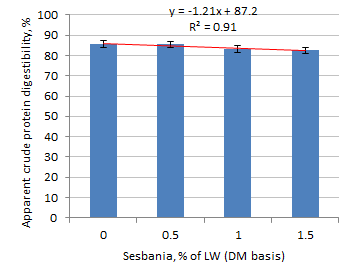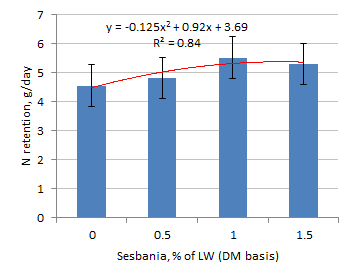|
Back to content |
Livestock-Based Farming Systems, Renewable Resources
and the Environment |
|
Effect of Sesbania sesban
foliage on intake, digestibility and N retention of growing goats
fed foliage of Operculina
turpethum forage as the basal diet
Vo Lam, Bui Phan Thu Hang and T R Preston*
Angiang University, Faculty of
Agriculture and Natural Resources, Vietnam
bpthang@agu.edu.vn
*TOSOLY, AA#48 Socorro, Santander, Colombia
Abstract
An experiment was carried out to evaluate digestibility by goats of foiage of
Operculina turpethum with or without supplementation of Sesbania sesban.
Four weaned crossbred goats (Bach Thao x local female), 12 – 13 kg and 4 months
of age were used. The basal diet was Operculina turpethum foliage fed ad libitum.
The design was a Latin Square with 4 treatments: (i) without
Sesbania (ii) supplement of Sesbania at 0.5% of body weigh on dry
matter basis, (iii) supplement of Sesbania at 1.0% of body weigh on dry matter basis and
(iv) supplement of Sesbania at 1.5% of body weigh on dry matter basis.
Apparent digestibility of crude protein was high on all diets with a slight
linear decline as the level of Sesbania was increased (Figure 2). DM intake and
nitrogen retention
showed curvilinear responses to level of Sesbania with the optimum at 1.0% of
LW (as DM) (Figure1 and 3).
 |
 |
| Figure 1. Effect of level of supplementation with Sesbania
sesban on DM intake of goats
fed a basal diet of foliage of Operculina turpethum |
Figure 2. Effect of level of supplementation with Sesbania
sesban on the apparent digestibility of crude protein in goats
fed a basal diet of foliage of Operculina turpethum |
 |
|
| Figure 3. ffect of level of supplementation with Sesbania
sesban on N retention in goats fed a basal diet of foliage of Operculina turpethum |
|
Key words: Browse, local feed resources, supplementation


